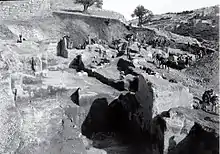Theodotos inscription
The Theodotos inscription is the earliest known inscription from a synagogue. It was found in December 1913 by Raymond Weill in Wadi Hilweh (known as the City of David).[1]
| Theodotus inscription | |
|---|---|
.jpg.webp) The Theodotus inscription in its current location | |
| Material | Limestone |
| Size | 75 x 41 cm |
| Writing | Ancient Greek |
| Created | 1st to 3rd centuries CE |
| Discovered | 1913 |
| Present location | Rockefeller Museum |
| Identification | IAA S 842 |
It is the earliest-known evidence of a synagogue building in the region of Palestine.[2]
The ten-line inscription is on an ashlar stone measuring 71x45cm. [1]
Discovery
The inscription was found during Weill's excavations, in a cistern labelled "C2". Weill described the cistern as being filled with "large discarded wall materials, sometimes deposited in a certain order, enormous rubble stones, numerous cubic blocks with well-cut sides, a few sections of columns: someone filled this hole with the debris of a demolished building".[3]
Inscription

Greek script
- ΘΕΟΔΟΤΟΣ ΟΥΕΤΤΗΝΟΥ ΙΕΡΕΥΣ ΚΑΙ
- ΑΡΧΙΣΥΝΑΓΩΓΟΣ ΥΙΟΣ ΑΡΧΙΣΥΝ(ΑΓΩ)
- Γ(Ο)Υ ΥΙΩΝΟΣ ΑΡΧΙΣΥΝ(Α)ΓΩΓΟΥ ΩΚΟ
- ΔΟΜΗΣΕ ΤΗΝ ΣΥΝΑΓΩΓ(Η)Ν ΕΙΣ ΑΝ(ΑΓ)ΝΩ
- Σ(ΙΝ) ΝΟΜΟΥ ΚΑΙ ΕΙΣ (Δ)ΙΔAΧ(Η)Ν ΕΝΤΟΛΩΝ
- ΤΟΝ ΞΕΝΩΝΑ ΚΑ(Ι TΑ) ΔΩΜΑΤΑ ΚΑΙ ΤΑ ΧΡΗ
- Σ(Τ)ΗΡΙΑ ΤΩΝ ΥΔΑΤΩΝ ΕΙΣ ΚΑΤΑΛΥΜΑ ΤΟΙ
- Σ(Χ)ΡΗΖΟΥΣΙΝ ΑΠΟ ΤΗΣ ΞΕ(Ν)ΗΣ ΗΝ ΕΘΕΜΕ
- Λ(ΙΩ)ΣΑΝ ΟΙ ΠΑΤΕΡΕΣ (Α)ΥΤΟΥ ΚΑΙ ΟΙ ΠΡΕ
- Σ(Β)ΥΤΕΡΟΙ ΚΑΙ ΣΙΜΩΝ(Ι)ΔΗΣ
Transliteration
Th[e]ódotos Ouettínou, ierèfs kaí | a[r]chisynágogos, yiós archisyn[agó]|g[o]y, yionós archisyn[a]gógou, oko|dómise tín synagog[í]n eis an[ágn]o||s[in] nómou kaí eis [d]idach[í]n entolón, kaí t[ó]n xenóna, ka[í tá] dómata kaí tá chri|s[t]íria tón ydáton eis katályma toí|s [ch]rízousin apó tís xé[n]is, ín etheme|l[ímo]san oi patéres [a]ytoú kaí oi pre||s[v]ýteroi kaí Simon[í]dis.
Translation
Theodotos son of Vettenus, priest and head of the synagogue (archisynagōgos), son of a head of the synagogue, and grandson of a head of the synagogue, built the synagogue (synagogē) for the reading of the law [nómou] and for the teaching of the commandments [didachín entolón], as well as the guest room, the chambers, and the water fittings as an inn for those in need from abroad, the synagogue which his fathers founded with the elders and Simonides.
Notes
- Suzanne Richard (2003). Near Eastern Archaeology: A Reader. Eisenbrauns. pp. 455–. ISBN 978-1-57506-083-5.
- Tripolitis, Antonia (2002). Religions of the Hellenistic-Roman Age. Wm. B. Eerdmans Publishing. p. 85. ISBN 978-0-8028-4913-7.
The earliest evidence of a synagogue building in Palestine is found in the Theodotus inscription discovered in Jerusalem
- Weill, 1920, p.98-100: "Des nouveaux bassins découverts, l'un est une citerne indubitable, profonde excavation rectangulaire à parois verticales, très analogue d'aspect à la citerne C1 du sud du chantier: il s'agit du bassin C2, qui s'ouvre, à une cote assez élevée, au fond de l'angle formé parle coude du chemin haut, sur le bord extrême du saillant de notre terrain à cette place... La citerne du nord dont il était question tout à l'heure, C2, est partiellement engagée sous le mur de clôture et sous le chemin, et nous n'avons pu la vider complètement. Pour autant que son exploration a été faite, elle s'esl montrée remplie de gros matériaux parlois jetés, parfois déposés avec un certain ordre, énormes moellons, nombreux blocs cubiques à parois bien taillées, quelques tronçons de colonnes: on a comblé ce trou avec les matériaux d'un édifice démoli. Plusieurs des blocs sortis de là sont décorés, en creux dans la pierre ou en couleur sur enduit de plâtre. Une autre pierre est un bloc rectangulaire portant une inscription qui nous renseigne d'heureuse manière, tant sur les installations balnéaires dont les vestiges subsistent aux alentours, que sur l'édifice disparu dont les débris ont rempli la citerne même. Cette inscription en langue grecque, rédigée par un certain Theodotos, sera longuement étudiée au chapitre VI ci-après; elle émane, comme nous verrons, d'une autorité juive locale du début de l'époque romaine, et commémore l'établissement dune installation pour les étrangers de passage, comprenant une synagogue, une hôtellerie et un balnéaire : ce sont, les restes mêmes de cette organisation et de ces édifices qui sont mis à jour par notre fouille."
Bibliography
| Wikimedia Commons has media related to Theodotos Inscription. |
Secondary sources
- John S. Kloppenborg, “Dating Theodotus (CIJ II 1404),” Journal of Jewish Studies 51 (2000) 243-280
- John S. Kloppenborg: The Theodotos Synagogue Inscription and the Problem of First-Century Synagogue Buildings. In: James H. Charlesworth (Hrsg.): Jesus and Archaeology. Eerdmans, Grand Rapids 2006, S. 236–282.
- Jonathan J. Price: Synagogue building inscription of Theodotos in Greek, 1 c. BCE–1 c. CE. In: Hannah M. Cotton u. a. (Hrsg.): Corpus Inscriptionum Iudaeae/Palaestinae. Bd. 1: Jerusalem, Teil 1. De Gruyter, Berlin 2010, S. 53–56 (online).
- Gustav Adolf Deissmann: Licht vom Osten. Das Neue Testament und die neuentdeckten Texte der hellenistisch-römischen Welt. 4., völlig neubearbeitete Auflage. Mohr, Tübingen 1923, S. 379–380.
- Rachel Hachlili: Ancient Synagogues – Archaeology and Art: New Discoveries and Current Research (= Handbook of Oriental Studies, Section 1: Ancient Near East. Band 105). Brill, Leiden 2013, S. 523–526. (online)
- Howard Clark Kee: The Transformation of the Synagogue After 70 C.E.: Its Import for Early Christianity. In: New Testament Studies. Band 36, Nr. 1, 1990, S. 1–24 (Extract).
- Howard Clark Kee: Defining the First-Century CE Synagogue: Problems and Progress. In: New Testament Studies. Band 41, Nr. 4, 1995, S. 481–500 (Extract).
- Max Küchler: Jerusalem. Ein Handbuch und Studienreiseführer zur Heiligen Stadt. Vandenhoeck & Ruprecht, Göttingen 2007, ISBN 978-3-525-50170-2.
- Charles Simon Clermont-Ganneau, Une inscription grecque sur bloc de calcaire, découverte à Jérusalem sur le mont Ophel, Comptes rendus des séances de l'Académie des Inscriptions et Belles-Lettres Année 1920 64-3 pp. 187-189
- Charles Simon Clermont-Ganneau. “Découverte a Jérusalem D'une Synagogue De L'epoque Hérodienne.” Syria, vol. 1, no. 3, 1920, pp. 190–197. JSTOR, www.jstor.org/stable/4195086
Primary sources
- Raymond Weill: La Cité de David. Campagne de 1913–1914. Geuthner, Paris 1920 (archive).